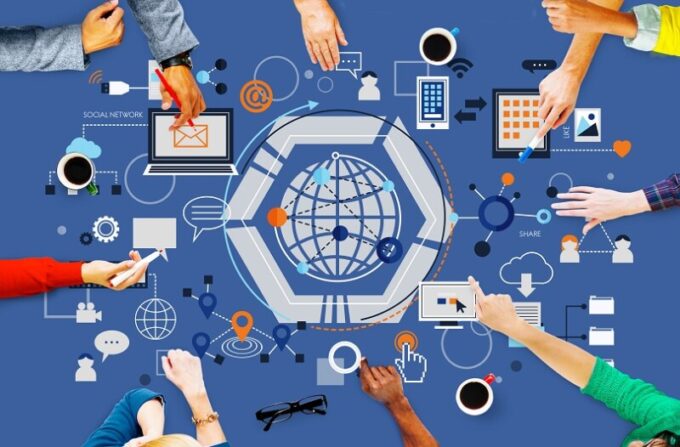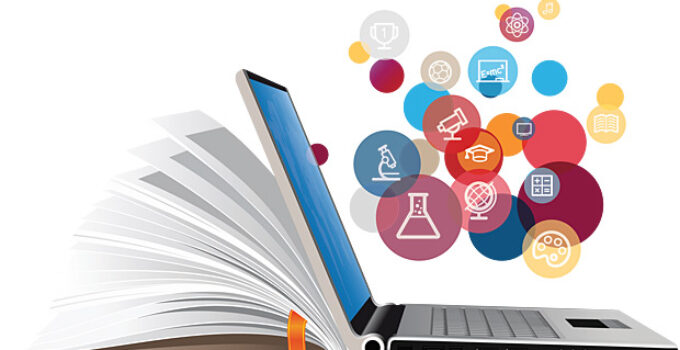Technology has transformed many aspects of life in the 21st Century, and education is no exception. Technology has revolutionized the way knowledge is shared, acquired, and imparted. Interaction between technology and education has created new opportunities for engagement, personalized learning and collaboration. The dynamic relationship between technology and education is explored in this article. It examines how digital innovations and tools enhance learning and help shape the future.
1. Collaborative Learning and Global Connections

Source: td.org
Digital tools have transformed the traditional classroom into a global learning community, fostering collaborative learning and facilitating global connections. Online collaboration platforms, video conferencing tools, and social media networks have opened doors for students and educators to connect and collaborate with peers from diverse geographical locations, cultural backgrounds, and educational institutions.
Through virtual classrooms and project-based learning, students can engage in meaningful collaborations, exchange ideas, and develop essential skills such as communication, teamwork, and cross-cultural understanding. These digital platforms also allow educators to invite experts from various fields into the classroom through video lectures, webinars, and virtual guest speakers, providing students with diverse perspectives and real-world insights. These digital tools prepare students for an increasingly interconnected and globalized society by bridging the gap between classrooms and the broader world.
Furthermore, online platforms like Thesis Rush allow students to collaborate on stubborn assignments and research projects. These platforms offer a space where students can connect with experienced academic writers and collaborate on their jobs, receiving expert guidance and assistance to enhance their learning outcomes.
Such collaborative opportunities, facilitated by digital tools, not only support students in their academic endeavors but also nurture their collective skills and expose them to different perspectives and approaches to problem-solving. By leveraging these collaborative learning opportunities and global connections, students can develop the skills needed to thrive in an interconnected world and collectively tackle complex challenges.
2. Professional Development for Educators
Digital tools benefit students and support educators in their professional development. Online platforms and communities provide opportunities for teachers to link, collaborate, and share best practices with colleagues from around the world. Webinars, virtual conferences, and online courses offer convenient and flexible options for educators to expand their knowledge, learn new pedagogical approaches, and stay updated on the latest research and trends in education.
Additionally, digital tools enable teachers to create and curate educational resources, design interactive lesson plans, and incorporate technology effectively into their classrooms. By equipping educators with the necessary skills and resources, technology enhances their teaching practices, fosters innovation, and promotes a culture of lifelong learning within the educational system.
3. Enhanced Assessment and Feedback Mechanisms

Source: strategyeducation.co.uk
Traditional assessment methods often need to provide timely and constructive feedback to students. However, digital tools have revolutionized the assessment process, offering new ways to evaluate and provide feedback on student performance. Online quizzes, interactive simulations, and intelligent assessment systems enable educators to gather immediate feedback, identify misconceptions, and tailor instruction accordingly.
Moreover, digital portfolios and e-portfolios allow students to showcase their work, reflect on their learning journey, and receive personalized feedback from educators and peers. These enhanced assessment and feedback mechanisms promote continuous improvement, empowering students to monitor their progress, set goals, and engage in self-directed learning.
4. Interactive and Immersive Learning Experiences
Digital tools and innovations have introduced immersive learning experiences beyond traditional textbooks and lectures. Augmented reality (AR), virtual reality (VR), and gamification techniques have revolutionized how students engage with educational content. AR and VR technologies allow learners to explore simulated environments, visit historical sites, conduct scientific experiments, and delve into complex concepts that were previously inaccessible.
These interactive and immersive experiences capture students’ attention and curiosity and enhance their retention and understanding of the subject matter. Moreover, gamification elements, such as badges, leaderboards, and rewards, motivate students and make learning more enjoyable, transforming the educational journey into an interactive and engaging adventure.
5. Personalized Learning

Source: elearningindustry.com
One of the key advantages of digital tools and innovations in education is their ability to facilitate personalized learning experiences. With the help of adaptive learning platforms, intelligent tutoring systems, and data-driven analytics, students can receive tailored instruction that caters to their needs, interests, and learning styles. These technologies enable educators to gather real-time data on students’ progress, identify areas of strength and weakness, and provide targeted interventions.
Furthermore, digital tools offer interactive and multimedia-rich content, allowing learners to engage with the material at their own pace and explore concepts through diverse modalities. By promoting personalized learning, technology empowers students to take ownership of their education and fosters a deeper understanding of the subject matter.
6. Digital Citizenship and Online Safety Education
Students need to develop skills and awareness regarding digital citizenship and online safety in an increasingly digital world. Digital tools and innovations play a crucial role in fostering responsible digital behavior and equipping students with the knowledge to navigate the digital landscape safely. Educational institutions are incorporating curriculum elements focusing on internet safety, cyberbullying prevention, privacy protection, information literacy, and responsible online communication.
Interactive educational platforms and simulations enable students to explore real-life scenarios and make informed decisions in a virtual environment. By integrating digital citizenship and online safety education, students become empowered digital citizens who can navigate the digital world responsibly, ethically, and securely, ensuring a positive and safe online experience for themselves and others.
7. Remote and Blended Learning

Source: campustechnology.com
The rise of digital tools and innovations has significantly expanded the possibilities for remote and blended learning models. In the wake of global events such as the coronavirus pandemic, online platforms, video conferencing tools, and learning management systems have become invaluable in facilitating uninterrupted education. Remote learning allows students to access educational content anywhere, overcoming geographical limitations and enabling flexible schedules.
Additionally, blended learning combines in-person and online elements, offering a hybrid approach leveraging the benefits of face-to-face interactions and digital resources. This approach allows students to engage in self-paced learning, collaborate with peers virtually, and receive individualized support from educators. Remote and blended learning models not only promote inclusivity and accessibility but also cultivate digital literacy, adaptability, and resilience among students, preparing them for a future where technology-mediated learning is increasingly prevalent.
Conclusion
The relationship between technologies and the educational system is transformative, shaping the future of education in remarkable ways. From personalized learning and collaborative experiences to interactive and immersive tools, the digital landscape offers unique opportunities to enhance learning experiences. By leveraging digital tools and innovations, educators can create dynamic and engaging environments that cater to diverse learners’ needs, foster global connections, provide access to vast resources, and revolutionize assessment and feedback mechanisms.
As technology advances, educational institutions must embrace these opportunities and adapt their pedagogical approaches, ensuring students are well-equipped with the skills and knowledge required in an increasingly digital and interconnected world.







